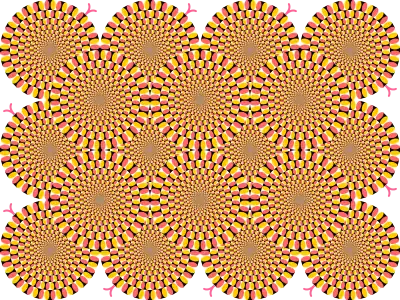Illusory motion
The term illusory motion, also known as motion illusion, is an optical illusion in which a static image appears to be moving due to the cognitive effects of interacting color contrasts, object shapes, and position.[1] Apparent motion is the most common type of illusory motion and is perceived when images are displayed in succession at a specific frame rate such as in a movie.

Types of illusory motion
- Induced motion
Induced movement works instead by moving the background around a fixed object.[2] Films such as Airplane! and Top Secret! use a fixed prop and move the background props to give the effect of induced motion.
- Motion aftereffect
Motion aftereffect occurs when one views moving stimuli for an extended period of time and then focus on a stationary object. The object will appear to move in the opposite direction of the moving stimuli.[3]
- Illusory motion in the eye
Illusory motion is perceived as movement in a number of ways. The first can manifest through the retinal image where the motion flows across the retinal mosaic. The perceived motion can also manifest by the eyes changing position. In either case, an aftereffect may occur.[4] Peripheral drift illusion is another variety of perceived movement in the eye.
- Illusory motion in the brain
Using an fMRI, Roger B. H. Tootell et al. were able to identify the area of the brain that is active when experiencing illusory motion. Tootell and his colleagues had participants view a set of concentric rings that would appear to move inward and outward. Participants would experience a motion aftereffect following the viewing the moving stimuli for 40 seconds. Participants showed an increased activity in the MT area of the brain.[5]
Occurrences
Theoretical example with the Illusion of motion: It appears that the sky is falling, while the reality is that the ocean is rising.
Illusory motion can occur in different circumstances. Stroboscopic images is where a series of static images are viewed in sequence at a high enough rate that the static images appear to blend into a continuous motion. An example of this is a motion picture. Optical art (or Op art.) is when artists use simple black and white patterns that create vivid illusions of motion, which are known as optical flow.
Stroboscopic images
Rotating objects can appear counter-rotating, stationary, or rotating under a strobe light. The apparent counter-rotation of wheels can also occur in daylight. Because of the illusion of counter-rotation in constant light, it is reasonable to assume that the eye views the world in a series of still images, and therefore the counter-rotation is a result of under-sampling (aliasing).[6]
There is, however, a strong counter-argument to this theory. A simple demonstration to disprove the idea is to view an apparent counter-rotation (that of a rotating drum) in mirror image. Subjective reports reveal that the counter-rotation appears in only one of the images (either the real or mirrored image when both are viewed simultaneously).[6]
Optical art
Apparent motion in optical art has been suggested to be caused by the difference in neural signals between black and white parts of an image. While white parts may produce an "on-off" signal, the black parts produce an "off-on" signal. This means for a black part and a white part presented simultaneously, the "on" part of the signal is separated in time, possibly resulting in the stimulation of motion detectors.
Another explanation is that afterimages from the retina cause a moiré that is hard to identify.
Gallery
In popular culture
American neo-psychedelia outfit Animal Collective used an illusory motion on the cover of their award-winning 2009 album Merriweather Post Pavilion.
See also
References
- Goldstein, E. Bruce (2010). Sensation and perception (8th ed.). Belmont, Calif.: Wadsworth Cengage Learning. ISBN 9780495601494.
- Krantz, Professor John H. "Induced Motion". Retrieved 24 August 2017.
- "Motion Aftereffect Demo (Waterfall)". Retrieved 29 Aug 2013.
- WHITESIDE TC (April 1963). "Visual Perception of Movement". Ann R Coll Surg Engl. 33: 267–81. PMC 2311643. PMID 14075040.
- "Letters to Nature" (PDF). Retrieved 5 April 2012.
- Kline, Keith; Holcombe, Alex O.; Eagleman, David M. (October 2004). "Illusory motion reversal is caused by rivalry, not by perceptual snapshots of the visual field". Vision Research. 44 (23): 2653–2658. doi:10.1016/j.visres.2004.05.030. PMID 15358060.
External links
- These Patterns Move, But it’s an Illusion by Smithsonian Research Lab



